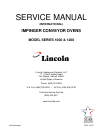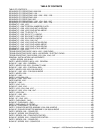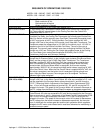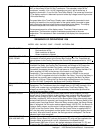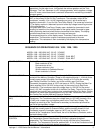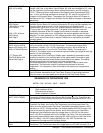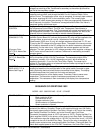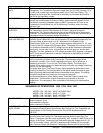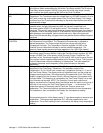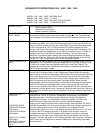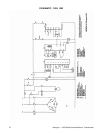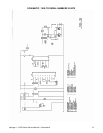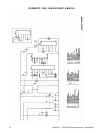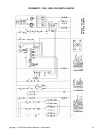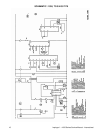
Impinger I -–1000 Series Service Manual - International 4
TIME TEMP DISPLAY The Time/Temp Display is energized when the Fan Switch is closed, supplying 120
VAC to the primary of the 12.6 volt Transformer. The secondary output of the
transformer, normally 13 to 14 VAC (depending on input), with a center tap, is
supplied to terminals 1,2, and 3 of the Time/Temp Display. The center tap is terminal
2. The display works on a balanced input and center tap voltage to each leg must be
1/2 the total reading.
The speed side of the Time/Temp. Display uses a slotted disc (cemented to tach.
coupling) to break the infra-red light beam of the optical switch (mounted on gear
motor) producing electrical pulses that are transmitted to the display. The display
converts these pulses into a read-out of minutes and seconds.
The temperature portion of the display uses a Thermistor Probe to sense oven
temperature. The thermistor outputs a resistance proportional to the oven
temperature. This resistance is then converted by the display into a temperature
reading.
SEQUENCE OF OPERATIONS 1106
MODEL 1006 - 240 VAC - 50HZ - 1 PHASE - NATURAL GAS
POWER SUPPLY Electrical Power to be supplied to the Oven by a three conductor service.
Red conductor is Hot
Black conductor is Neutral
Green conductor is Ground
CONTROL BOX AUTO
COOL DOWN
When the temperature in the Control Box reaches 120°F + 3°, the Cooling Fan
Thermostat will switch power to the Control Box Cooling Fan. The Thermostat will
interrupt power to the Cooling Fan when the Control Box temperature falls to 100°F +
3°.
MAIN FAN CIRCUIT Electrical power is permanently supplied to the normally open contacts of the Double
Pole Main Fan Relay, the Cooling Fan Thermostat, and through a 3A Fuse to the
normally open Double Pole Main Fan Switch, and the normally open Cool Down
Thermostat (thermostat closes at 160°F and opens at 140°F). Closing the Main Fan
Switch supplies 240 VAC to the primary of the control circuit Step Down
Transformer. (The transformer steps the voltage down to 120VAC for the control
circuit) 120 VAC is supplied to the coil of the Main Fan Relay. The coil of the Relay is
energized, the normally open contacts now close, energizing the Main Fan Motor
through one 10A fuse. Closing the Fan Switch also supplies power to the Cooling
Fan, the 12.6 VAC Transformer, the Burner and Conveyor Switches
TRANSFORMER (12.6
VAC)
Upon closure of the Fan Switch, 120 VAC is supplied to the primary of the 12.6 VAC
Transformer. The Transformer steps the voltage down to 12.6 VAC (normally 13 to
14 VAC) with a center tap, and supplies power to the Time/Temp Display. The
voltage from each leg of the Transformer's secondary to the center tap should be
one half of the secondary voltage.
BURNER CIRCUIT Closing the Fan Switch and the normally open Burner Switch supplies 120 VAC
through the Air Pressure Switch, to the normally open contacts of the Burner Motor
Relay, and the primary of the 24 VAC Step Down Trans-former. The Transformer
secondary supplies 24 VAC to the coil of the Burner Motor Relay (the normally open
contacts close within 30 seconds), and through the Burner Air Pressure Switch to the
normally open Centrifugal Switch. When the Relay contacts close, the Burner Blower
Motor is energized. As this motor reaches approximately 1600 R.P.M., the Burner Air
Pressure Switch closes, and the motor's internal centrifugal switch closes supplying
24 VAC to the Gas Control Valve. When the Gas Control Valve is supplied with 24
VAC, the pilot valve is energized, and the igniter circuit is energized. Ignition should
now occur. After pilot flame is proven, the main gas valve is energized. The Burner
Indicator Light is also energized.
CONVEYOR DRIVE
(S/N 4390 AND UP)
Closing the fan switch and the normally open conveyor switch supplies 120 VAC to
the Motor Control Board .AC volts are converted to DC volts and are supplied to the
Conveyor Motor at terminals A+ and A-. Adjustment of the Speed Control
Potentiometer (5000 ohm 10 turn ) will change resistance at terminals P1, P2, and
P3 varying the DC voltage to the motor. The speed of the conveyor motor will



